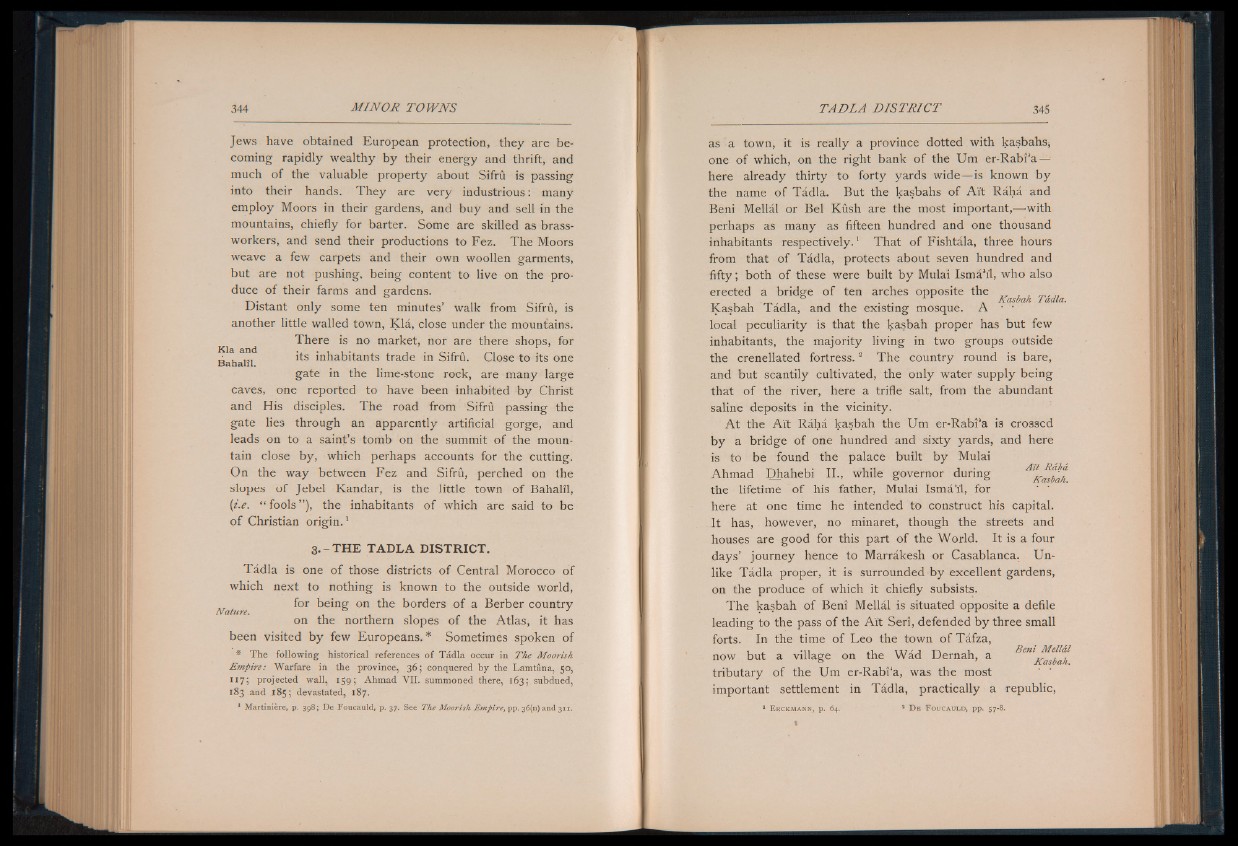
Jews have obtained European protection, they are becoming
rapidly wealthy by their energy and thrift, and
much of the valuable property about Sifru is passing
into their hands. They are very industrious: many
employ Moors in their gardens, and buy and sell in the
mountains, chiefly for barter. Some are skilled as brass-
workers, and send their productions to Fez. The Moors
weave a few carpets and their own woollen garments,
but are not pushing, being content to live on the produce
of their farms and gardens.
Distant only some ten minutes’ walk from Sifru, is
another little walled town, Kla, close under the mountains.
There is no market, nor are there shops, for
„ . ... its inhabitants trade in Sifru.Bahalil. Close to its one
gate in the lime-stone rock, are many large
caves, one reported to have been inhabited by Christ
and His disciples. The road from Sifru passing the
gate lies through an apparently artificial gorge, and
leads on to a saint’s tomb on the summit of the mountain
close by, which perhaps accounts for the cutting.
On the way between Fez and Sifru, perched on the
slopes of Jebel Kandar, is the little town of Bahalil,
{i.e. “ fools ” ), the inhabitants o f which are said to be
of Christian origin.1
3.-THE TADLA DISTRICT.
Tadla is one o f those districts of Central Morocco of
which next to nothing is known to the outside world,
for being on the borders of a Berber country
Nature. & J
on the northern slopes of the Atlas, it has
been visited by few Europeans.* Sometimes spoken of
* The following historical references of Tadla occur in The Moorish
Empire: Warfare in the province, 36; conquered by the Lam tun a, 50,
117; projected wall, 159; Ahmad VH. summoned there, 163; subdued,
183 and 185; devastated, 187.
1 Martiniere, p. 398; De Foucauld, p. 37. See Tkc Moorish }r.mpire, pp. 36(11) and 311.
as a town, it is really a province dotted with kasbahs,
one of which, on the right bank of the Um er-Rabi‘a—-
here already thirty to forty yards wide— is known by
the name of Tadla. But the kasbahs of A it Raha and
Beni Mellal or Bel Kush are the most important,— with
perhaps as many as fifteen hundred and one thousand
inhabitants respectively.1 That of Fishtala, three hours
from that of Tadla, protects about seven hundred and
fifty ; both of these were built by Mulai Isma'il, who also
erected a bridge of ten arches opposite the ;
s . . . Kasbah Tadla.
Kasbah Tadla, and the existing mosque. A • ■
local peculiarity is that the kasbah proper has but few
inhabitants, the majority living in two groups outside
the crenellated fortress.2 The country round is bare,
and but scantily cultivated, the only water supply being
that of the river, here a trifle salt, from the abundant
saline deposits in the vicinity.
A t the Alt Raha kasbah the Um er-Rabi‘a is crossed
by a bridge of one hundred and sixty yards, and here
is to be found the palace built by Mulai
Ahmad Dhahebi II., while governor during ^Kasbah
the lifetime of his father, Mulai IsmaAl, for
here at one time he intended to construct his capital.
It has, however, no minaret, though the streets and
houses are good for this part of the World. It is a four
days’ journey hence to Marrakesh or Casablanca. Unlike
Tadla proper, it is surrounded by excellent gardens,
on the produce of which it chiefly subsists.
The kasbah of Beni Mellal is situated opposite a defile
leading to the pass of the Ait Seri, defended by three small
forts. In the time of Leo the town of Tafza,
now but a village on the Wad Dernah, a BentKalbah
tributary of the Um er-Rabi‘a, was the most
important settlement in Tadla, practically a republic,